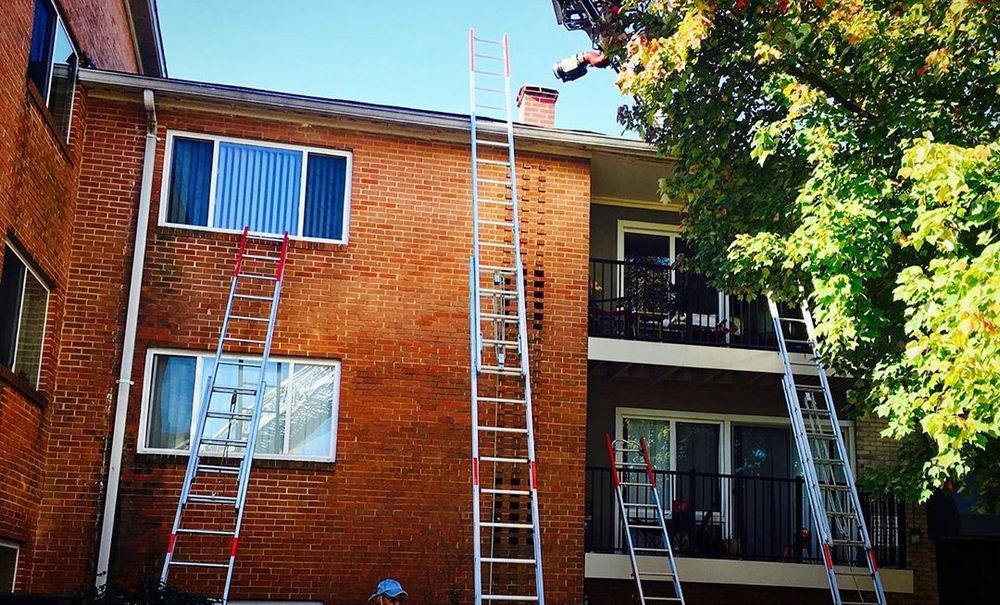Most consumers get so excited about purchasing or building a new home that they overlook some practical maintenance elements. Getting rid of cobwebs or repairing peeling paint on vaulted ceilings and eaves.
Some even end up watching helplessly as bees, bats, and myriads of other pests occupy out-of-reach areas in their homes. Therefore, you must learn how to reach high places with a ladder.

You can use a ladder for simple maintenance procedures such as light paint jobs, cleaning a dirty skylight, or even replacing a light bulb.
Following the steps below will help you maintain a solid footing and a stable top even when the circumstances are less than ideal.
Have you ever been halfway up a ladder and felt it moving to one side under your feet? You probably realized that you should have made sure the ladder feet were stable before beginning your ascent.
However, even with the various obstacles around your home, ladder climbing can be safe.
One of the most crucial steps to a safe ladder setup is setting your ladder at the appropriate angle. If the slope is too steep, it can tip over backward.
On the other hand, the bottom could slide out or bend when the curve is too big. It would be best to consider using scaffolding for high ceilings when obstacles make it difficult to set up your ladder at the right angle.
Besides establishing an even base, you should also ensure that your ladder’s feet cannot slip backward. You can flip your ladder with the spurs poking into the surface if you are working on a soft surface.
On the other hand, screwing down the cleats will suffice on decks. Before setting up your ladder on hard surfaces, you can get rid of the sand that may cause your ladder to slip by cleaning the bottom of your ladder’s feet and sweeping away the sand.
If you still think that your ladder could slip away, tie ropes to an anchored object close to the base of the wall. Tie the other end of the ropes to both ladder legs below the lowest rung.
It is essential to ensure the top of your ladder cannot slide when the rails are resting against the wall. It would be best if the ladder were vertical, with the top resting on a level surface.
You should always avoid angling your ladder to the right or left to reach a remote area. However, that is not a problem since you can find a ladder to reach a 20-foot ceiling in the market.
Securing the top of your ladder to prevent sliding is essential, especially when planning to use the ladder severally in the exact location.
If you are working on the roof, the ties will keep the ladder from sliding when you step to and from your roof.
Although ladders make your job easier, you may need alternatives when a ladder is not readily available, or a fear of height arises.
For instance, you can use trestles, scaffolds, and aerial lifts to paint high places without a ladder. Some offer the painter more safety and convenience on an interior and exterior basis.
You can make scaffolding for high ceilings by joining several platforms with bars and screws for additional support.
However, you need to choose an alternative that best fits your space while maintaining your safety.
There is a wide range of ladder configurations with distinctive features. They include the following:
Before settling on a particular ladder, you should understand how to determine its maximum reach from its height. The full standing level safe on a stepladder is two steps down from the top.
Also, the highest safe reaching height is about 4 feet higher than the ladder’s height. For instance, a 4-foot ladder can safely reach a ceiling 8 feet away.
When cleaning high places such as ceilings, you can use telescopic cleaning poles alongside your ladder.
Since many such poles can adjust between five and thirty feet, you can tackle dust on your ceiling while safely standing on your ladder or floor.
Additionally, you can attach a forked duster to the end of the cleaning pole, especially if you have fans on your high ceilings.
You have to deal with maintenance work from time to time. High places in your home, such as the ceiling, can be challenging to reach, especially when you lack the appropriate tools.
So it would help if you determined how to reach high places with ladders. It would be best if you also remembered that almost all ladders are rated based on the amount of weight they can carry.
Before settling on a particular type of ladder, ensure that it suits your problem because different ladders have varying capabilities.